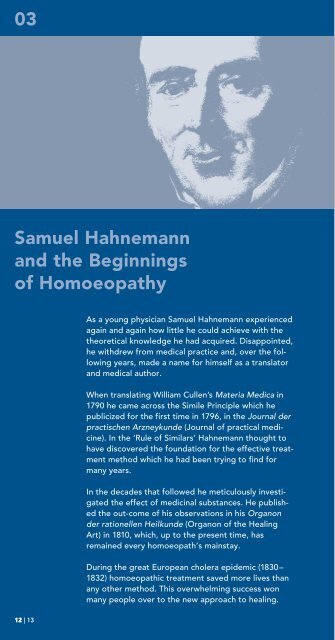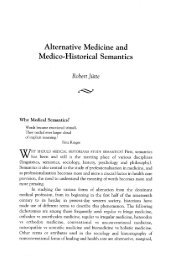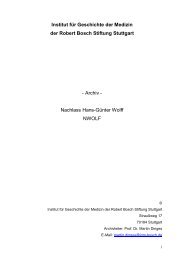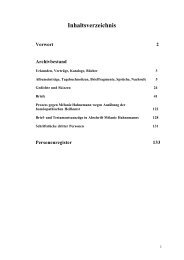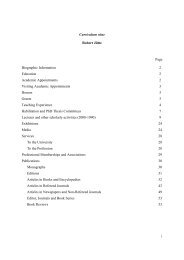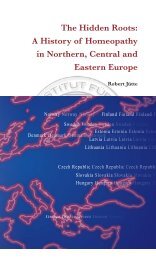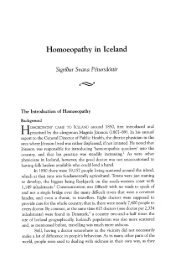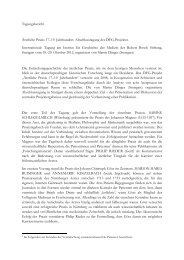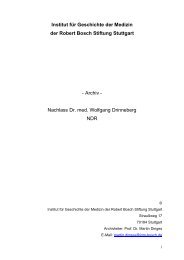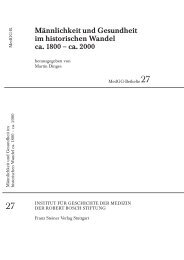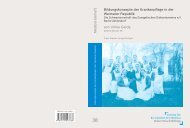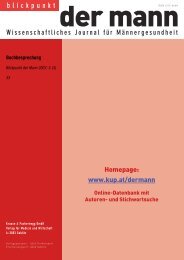pathy Homoeopathy – A Medical Approach and Its History
pathy Homoeopathy – A Medical Approach and Its History
pathy Homoeopathy – A Medical Approach and Its History
You also want an ePaper? Increase the reach of your titles
YUMPU automatically turns print PDFs into web optimized ePapers that Google loves.
03<br />
Samuel Hahnemann<br />
<strong>and</strong> the Beginnings<br />
of Homoeo<strong>pathy</strong><br />
12 | 13<br />
As a young physician Samuel Hahnemann experienced<br />
again <strong>and</strong> again how little he could achieve with the<br />
theoretical knowledge he had acquired. Disappointed,<br />
he withdrew from medical practice <strong>and</strong>, over the follow<br />
ing years, made a name for himself as a translator<br />
<strong>and</strong> medical author.<br />
When translating William Cullen’s Materia Medica in<br />
1790 he came across the Simile Principle which he<br />
publicized for the first time in 1796, in the Journal der<br />
practischen Arzneykunde (Journal of practical medicine).<br />
In the ‘Rule of Similars’ Hahnemann thought to<br />
have discovered the foundation for the effective treatment<br />
method which he had been trying to find for<br />
many years.<br />
In the decades that followed he meticulously in ves tigat<br />
ed the effect of medicinal substances. He pub lished<br />
the out-come of his observations in his Organon<br />
der rationellen Heilkunde (Organon of the Healing<br />
Art) in 1810, which, up to the present time, has<br />
remained every homoeopath’s mainstay.<br />
During the great European cholera epidemic (1830<strong>–</strong><br />
1832) homoeopathic treatment saved more lives than<br />
any other method. This overwhelming success won<br />
many people over to the new approach to healing.<br />
[11] Samuel Hahnemann<br />
(1755<strong>–</strong>1843) by Mélanie<br />
Hahnemann, 1835<br />
© IGM picture library<br />
Samuel Hahnemann: Life <strong>and</strong> Work [11]<br />
[12] Samuel Hahnemann, Organon<br />
der rationellen Heilkunde, first<br />
edition, Dresden 1810, title page<br />
© IGM picture library<br />
1755 born 10th April in Meißen/Germany the son of<br />
porcelain painter Christian Gottfried Hahnemann <strong>and</strong><br />
his wife Johanna Christiane née Spieß<br />
1775<strong>–</strong>1777 medical studies in Leipzig<br />
1777 further studies in Vienna <strong>and</strong><br />
first work experience<br />
1779 doctorate in Erlangen/Germany<br />
1780 first practice in Hettstedt near Halle/Saale<br />
1782 marriage to Henriette Küchler in Dessau<br />
1783 <strong>–</strong> 1785 public health officer in Gommern<br />
(near Magdeburg)<br />
1785 <strong>–</strong> 1789 relocation to Dresden <strong>and</strong> opening of<br />
practice; work as coroner <strong>and</strong> registrar in Dresden<br />
municipal hospitals; growing dissatisfaction with orthodox<br />
medicine <strong>and</strong> temporary withdrawal from practice;<br />
translation of French <strong>and</strong> English medical <strong>and</strong> pharmaceutical<br />
writings; own scientific publications<br />
1789 <strong>–</strong>1790 relocation to Leipzig, then to Stötteritz<br />
near Leipzig; continuation of scientific research; translation<br />
of the Scottish physician William Cullen’s Materia<br />
Medica <strong>and</strong> selfexperiments with cinchona bark


